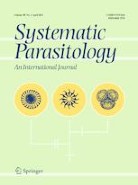Ver ítem
- xmlui.general.dspace_homeCentros Regionales y EEAsCentro Regional Santa FeEEA RafaelaArtículos científicosxmlui.ArtifactBrowser.ItemViewer.trail
- Inicio
- Centros Regionales y EEAs
- Centro Regional Santa Fe
- EEA Rafaela
- Artículos científicos
- Ver ítem
Morphological descriptions of the nymph and adults of Ornithodoros clarki, the larva and nymph of Ornithodoros rondoniensis, with notes on their phylogenetic relationships
Resumen
Based on tick specimens collected recently in Mexico, Nicaragua, Panama and Brazil, we provide morphological descriptions of the nymph and adults of Ornithodoros clarki Jones & Clifford, 1972 from the first three countries, and the larva and nymph of Ornithodoros rondoniensis (Labruna, Terassini, Camargo, Brandão, Ribeiro & Estrada-Peña, 2008) from Brazil. Also, an analysis of mitochondrial 16S rDNA sequences was performed to analyze the phylogenetic
[ver mas...]
Based on tick specimens collected recently in Mexico, Nicaragua, Panama and Brazil, we provide morphological descriptions of the nymph and adults of Ornithodoros clarki Jones & Clifford, 1972 from the first three countries, and the larva and nymph of Ornithodoros rondoniensis (Labruna, Terassini, Camargo, Brandão, Ribeiro & Estrada-Peña, 2008) from Brazil. Also, an analysis of mitochondrial 16S rDNA sequences was performed to analyze the phylogenetic relationships of these tick species. Adults and nymphs of O. clarki and O. rondoniensis are unique among the Argasidae family by presenting exceptionally large spiracular plates with small goblets, and an integument with smooth polygonal mammillae. However, these two species are morphologically distinct based on specific patterns of coxal folds, idiosomal mammillae and pilosity, and female genital flap. In contrast, the larvae of O. clarki and O. rondoniensis are morphologically identical, except for a general larger size of the former species; this slight difference is corroborated by Principal Component Analysis (PCA) by using 40 morphometric variables. Phylogenetic analyses including 16S rDNA partial sequences of different Ornithodoros taxa from Central and South America indicate that O. rondoniensis from Brazil diverges from O. clarki from Mexico, Nicaragua and Panama. However, phylogenetic distance separating both alleged species is similar or slightly lower than the distances depicted for conspecific populations of a few other Ornithodoros species. Nonetheless, our primary criterion to maintain O. rondoniensis as a valid species is because its adult and nymphal stages do present distinct morphological traits that easily distinguish these postlarval stages from O. clarki.
[Cerrar]

Autor
Labruna, Marcelo B.;
Nava, Santiago;
Rebollo Hernández, Andrea;
Guzman Cornejo, Carmen M.;
Hernández, Ligia V.;
Domínguez, Lillian;
Muñoz-Leal, Sebastian;
Venzal, José Manuel;
Fuente
Systematic Parasitology (Published: 26 March 2021)
Fecha
2021-03-26
Editorial
Springer
ISSN
0165-5752
1573-5192
1573-5192
Formato
pdf
Tipo de documento
artículo
Palabras Claves
Derechos de acceso
Restringido
 Excepto donde se diga explicitamente, este item se publica bajo la siguiente descripción: Creative Commons Attribution-NonCommercial-ShareAlike 2.5 Unported (CC BY-NC-SA 2.5)
Excepto donde se diga explicitamente, este item se publica bajo la siguiente descripción: Creative Commons Attribution-NonCommercial-ShareAlike 2.5 Unported (CC BY-NC-SA 2.5)

